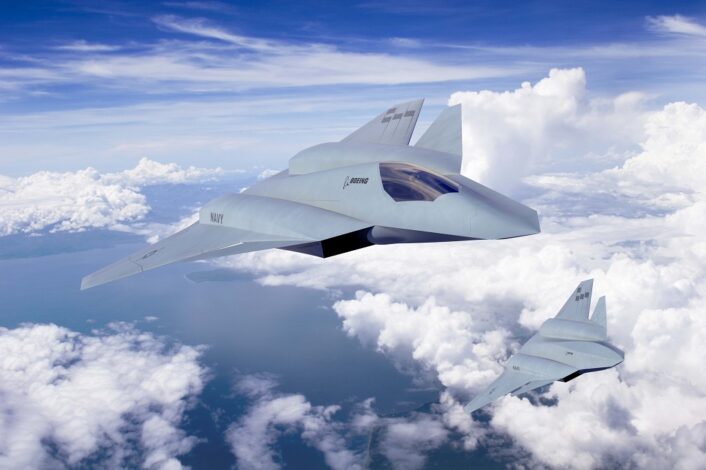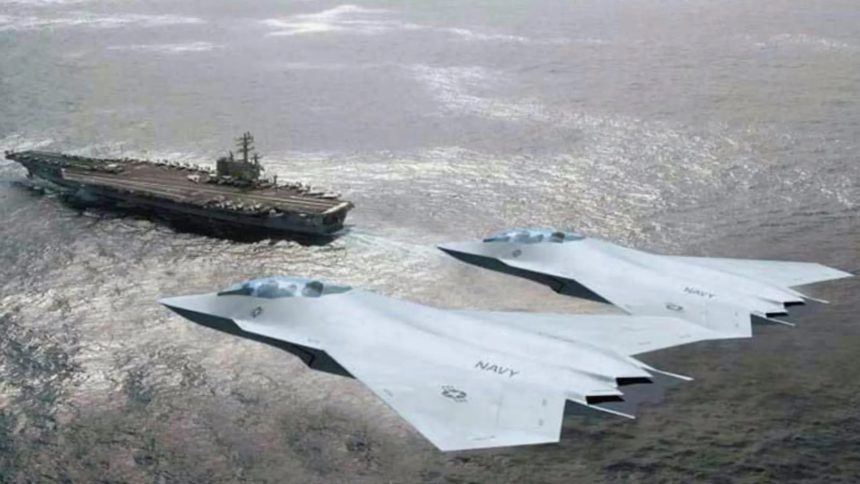The Navy’s decision could shield the F/A-XX program from the impacts of the Air Force’s NGAD review, especially as the source selection process is ongoing, with a winner expected next year.
Similarly to the U.S. Air Force, the U.S. Navy is developing a 6th generation fighter jet, called F/A-XX. While the Air Force previously said the two programs are interconnected and is sharing its developments, the Navy has now said that it will develop its aircraft independently.
The revelation was part of an interview released to Aviation Week by Rear Adm. Michael Donnelly, director of the air warfare division in the Office of the Chief of Naval Operations. The Navy, since the beginning, has always been tightlipped about the secretive Next Generation Fighter, with few details released.
The Navy is currently in the source selection phase, with proposals from three companies, as confirmed by both Donnelly and Admiral Lisa Franchetti, the Chief of Naval Operations. While not explicitly stated, the three companies are believed to be Boeing, Lockheed Martin and Northrop Grumman.
The F/A-XX contract is planned to replace both the F/A-18E/F and EA-18G, complementing the F-35C in the Carrier Air Wings. Fiscal pressure and tight budgets, however, could delay the entire process and, as a consequence, the fielding of the new aircraft.
F/A-XX and NGAD
According to Rear Adm. Donnelly, the new carrier-based fighter will be affordable, versatile and independent of Air Force-funded technologies such as an adaptive-cycle turbofan engine. While the service already said it would require a different airframe than the Air Force’s NGAD, however, other systems were not mentioned.
Initially, the Navy appeared interested in the adaptive-cycle technology being developed for the Next-Generation Adaptive Propulsion (NGAP) program. In the past decade, however, propulsion plans for the two services have diverged, according to Donnelly.

“We’re looking at more of a derivative-type engine solution,” said Donnelly. “That’s just one example where we probably are different in many ways from the Air Force. In totality, they are two unique programs from an acquisition point of view and also going forward, so we’re relatively independent of each other at this point.”
As reported earlier, the Air Force’s Next Generation Air Dominance (NGAD) is currently undergoing an extensive review that could reshape its future and have major implications for the Air Force’s approach to air superiority. The Navy’s decision to move forward independently might shield the F/A-XX from the results of the NGAD’s review and the subsequent decisions.
One of the aspects of NGAD currently being reviewed is the cost, which is expected to be in the hundreds of millions per aircraft and has not been deemed affordable. On the other hand, the Navy is still confident in the suitability and affordability of the F/A-XX and is committed to move forward with the program.
“We have to have an affordable platform to make it relevant to our force structure and force design, so we’ve got that in mind,” said Donnelly. “We think we’ve got an affordable solution that supports our force structure of the future.”
According to Donnelly, the F/A-XX program is on track for the Milestone B decision to move the Engineering and Manufacturing Development (EMD) phase by the end of fiscal year 2025. In fact, contrary to the Air Force, the Navy appears to be happy with the current performance requirements it has put out for the Next Generation Fighter.
“We feel really good through the concept development that we’ve got the right bracket for those requirements and the attributes we need to deliver the capability,” Donnelly says. “We’ll continue to look at that as we go through the next phases of the acquisition process and make smart decisions.”

However, both programs appear to be under budgetary pressure, as both services are currently working on multiple large programs. In the Navy’s case, the 2025 budget for the new aircraft suffered a cut of 67%, with the $10.3 billion requested between 2025 and 2028 reduced to just $3.3 billion. The senate voted to restore $450 million to the budget but, even if approved, there would still a cut of 59% compared with last year’s budget.
“Any time we are causing budget perturbations, we’ve got to consider what that does to schedule,” said Donnelly. “But obviously the later we wait, the more challenging it is to continue to pull that [schedule to the] left.”
Another difference between the Navy’s and Air Force’s 6th gen fighter could be their roles. While the latter envisions its new aircraft mainly as an air superiority fighter, the Navy wants it to be multirole, optimized for air-to-surface strike but still capable of fleet defense.
“The central focus of its design is to be able to conduct long-range fires, sea control and those types of missions. Inherent in its design is its ability to participate in fleet defense,” Donnelly says. “We can’t afford to have a break-glass capability or a really unique single-mission or single-phase-of-operation focus.”
As explained by Aviation Week, the Navy traditionally divides its fighters assigned to carrier air wings between two primary missions: air-to-surface, also defined as long-range strike and sea control, and air-to-air, also known as fleet defense. The former is primarily assigned to the F-35C, while the latter is assigned to the F/A-18E/F, which entered service initially with the long-range strike role.
A final difference is the manned or unmanned debate. The Air Force left the door open for an optionally manned configuration, which was also the initial configuration proposed for the F/A-XX. However, the Navy has now opted for a fully manned platform.
“F/A-XX is intended to be a manned platform,” Donnelly says, noting that the “F/A-XX will really be our pivot point from a manned air wing to a hybrid future, with a manned-unmanned air wing.”
What we know about F/A-XX
The F/A-XX is the strike fighter component within the Next Generation Air Dominance (NGAD) Family of Systems (FoS). The requirement for this aircraft has been around since 2008, with a formal Request for Information in 2012, to replace the F/A-18E/F Super Hornet in the 2030s.
Later, the F/A-XX was included in the NGAD program which, by the way, is a separate program from the identically named Air Force program. The Navy says that its “specific capabilities and technologies are under development, however analysis shows it must have longer range and greater speed, incorporate passive and active sensor technology, and possess the capability to employ the longer-range weapons programmed for the future”.

The NGAD FoS will include unmanned platforms with F/A-XX as the quarterback, exploiting the Manned/UnManned Teaming (MUM-T) concept to reduce risk to the manned aircraft, while simultaneously increasing capability, capacity, and survivability. The new MQ-25 Stingray will be the first unmanned asset to employ this capability, extending the strike range and enhancing maneuverability of the Carrier Air Wing.
Continued development of MUM-T will enable information sharing across a distributed force, increasing survivability, reducing risk to manned aircraft, and ensuring weapons capacity. The Navy is evaluating the appropriate mix of F/A-XX, manned and unmanned platforms to ensure the most lethal and affordable CVW possible, depending also on the maturity of autonomy and Machine Learning technologies.
The Navy envisions future unmanned air vehicles with survivable planforms, sensors, and robust autonomy able to find, fix, identify, track, engage, and assess land, sea, and air targets. These UAVs will be employed alongside manned aircraft and unmanned attritable assets to enable integrated kinetic and non-kinetic fires at tactically relevant ranges in multidomain operations.
In a 2021 document, the Navy showed a fictional F/A-XX operating in a MUM-T environment with four drones, whose shape represents the MQ-25. Interestingly, the drones are shown employing Air-to-Air (AA), Electronic Warfare (EW) and Command and Control (C2) payloads, much like the Loyal Wingman drones currently being developed. This falls in line with the service envisioning Unmanned Air Systems (UAS) to fill refueling, communications relay, logistics, airborne electronic attack, strike, and ISR&T missions in the future air wing.









